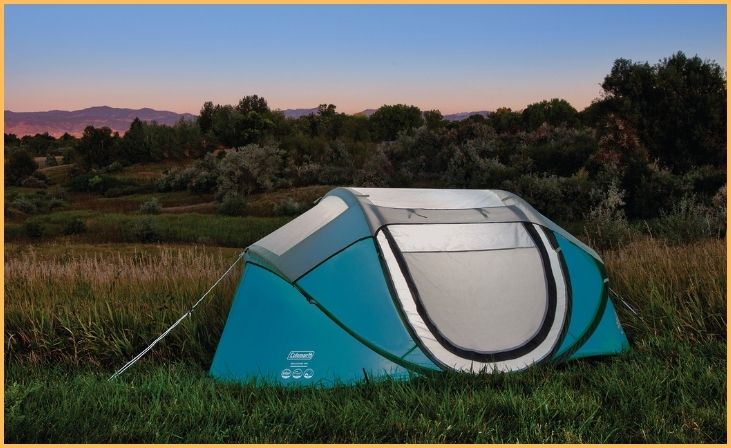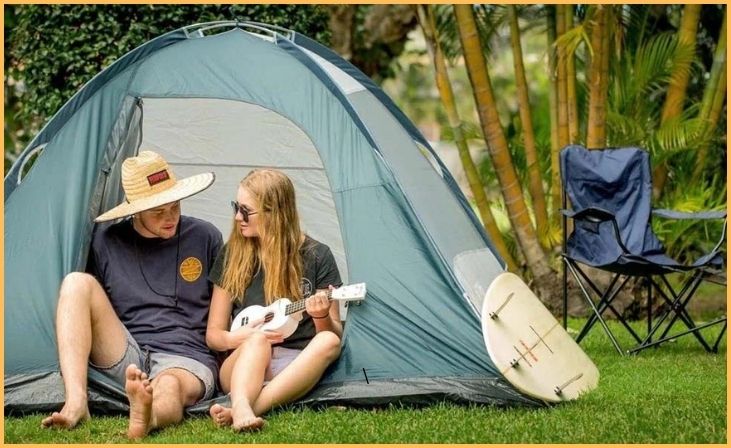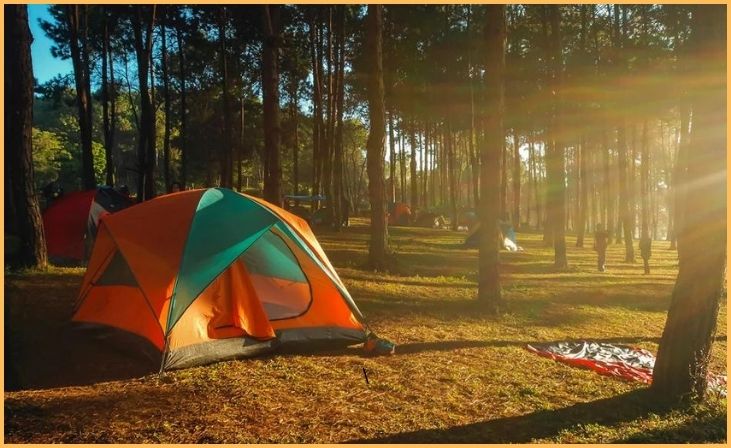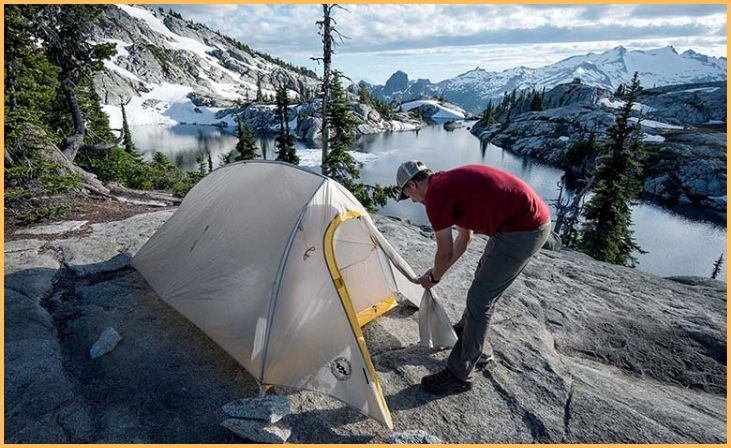Camping in the great outdoors is a truly exhilarating adventure. The allure of spending time in nature, far away from the hustle and bustle of everyday life, is a call that many of us heed. The crackling campfire, the starry night sky, and the peaceful sounds of the wilderness make memorable experiences that stay with us for a lifetime.
However, as any seasoned camper knows, Mother Nature can be quite unpredictable. What starts as a sunny day can quickly turn into a rainy, damp ordeal, and that’s when the true value of a reliable waterproof camping tent becomes apparent.
In this comprehensive guide, we’re here to be your compass through the world of waterproof camping tents. We want to ensure that your camping experience remains a source of joy, no matter what weather conditions you encounter. Whether you’re an experienced outdoor enthusiast or a novice camper, we’re here to help you make the right choice when selecting the best waterproof tent to keep you dry during those unexpected rainy camping trips.
Why Waterproof Tents Matter
The Importance of Staying Dry
Camping is all about embracing the outdoors, but it’s equally important to stay comfortable and dry during your adventures. Imagine waking up in the middle of a rainstorm with water seeping through your tent’s fabric. It can be a less-than-ideal experience. That’s why having a waterproof tent is essential for any camping trip.
Waterproof vs. Water-Resistant Tents
Understanding the difference between waterproof and water-resistant tents is crucial when selecting the right one for your camping needs. Water-resistant tents are designed to withstand light rain and drizzles. They will keep you dry in mild conditions, but they aren’t suitable for heavy downpours. On the other hand, waterproof tents are constructed to handle even the most intense rainstorms, ensuring you and your gear remain dry, no matter how hard it pours.
Types of Waterproof Tents

Pop-Up Tents
Pop-up tents are a popular choice for campers who value simplicity and speed in setting up their shelter. These tents are typically designed with waterproof materials, which means that they provide adequate protection against rain. The convenience of a pop-up tent is unbeatable, making it a great option for novice campers or anyone who wants a hassle-free camping experience.
Dome Tents
Dome tents are known for their stability, especially in windy and rainy conditions. Their design allows them to shed rain and snow effectively. Look for dome tents equipped with a rainfly extension. A rainfly is a separate waterproof cover that goes over the tent, providing an extra layer of protection against the elements. This additional layer helps keep the interior of your tent dry, even during prolonged rain.
Cabin Tents
For those embarking on family camping trips, cabin tents are a fantastic choice. These tents offer ample space for multiple campers and gear, making them ideal for family adventures. When selecting a cabin tent, ensure it comes with a high-quality rainfly. The rainfly will shield your tent from heavy rain and keep everyone inside cozy and dry.
Backpacking Tents
Backpacking enthusiasts understand the importance of having a lightweight and compact waterproof tent. These tents are designed with portability in mind, making them easy to carry during long treks. Look for backpacking tents made of waterproof materials and equipped with rainfly options for superior weather protection. This way, you can enjoy the great outdoors without worrying about getting wet.
Also Read:- Hiking Trails In The Rocky Mountains
What to Consider When Choosing a Waterproof Tent

Size and Space
When selecting a waterproof tent, size matters. Consider the number of campers you’ll be accommodating and the gear you need to store. A tent should provide ample space for everyone to sleep comfortably. Additionally, you’ll want space to store your gear and move around without feeling cramped.
Rainfly
The rainfly is a critical component of any waterproof tent. It’s a separate, waterproof cover that goes over the top of your tent. A high-quality rainfly can mean the difference between staying dry and getting soaked during a rainstorm. When choosing a tent, make sure it comes with a durable, well-fitting rainfly.
Material
The material of your tent plays a significant role in its waterproofing capabilities. Look for tents made from high-denier fabric, which is more resistant to tears and punctures. Additionally, ensure that the seams of the tent are sealed to prevent water from seeping through. High-quality materials and sealed seams are key to keeping water out and staying dry inside your tent.
Setup
Camping is a time to relax and enjoy the outdoors, so you don’t want to spend hours struggling to set up your tent, especially in bad weather. Look for tents with features like color-coded poles and straightforward setup instructions. These design elements make the setup process quick and easy, ensuring that you can enjoy your camping experience without unnecessary stress.
Ventilation
While keeping the rain out is essential, you must also consider ventilation. Even in wet weather, condensation can build up inside your tent. Look for tents with windows, vents, and mesh panels that provide adequate airflow. Proper ventilation will help reduce condensation and keep the interior of your tent comfortable and dry.
Easy Setup Pop-Up Camping Tents for Beginners

1. Size and Capacity:
When selecting a pop-up tent, it’s essential to determine how many people will be using it. Pop-up tents come in various sizes, ranging from one-person to multi-person options. Ensure that the tent can comfortably accommodate your group. Adequate space is crucial for a comfortable camping experience, and it’s important to consider not only the number of campers but also any gear or equipment you plan to keep inside.
2. Weather Resistance:
To stay comfortable and dry during various weather conditions, check the tent’s weather resistance features. Look for a tent with a rainfly, which is a waterproof cover that goes over the tent to protect it from rain and moisture. Additionally, good ventilation is important for hot weather. Proper airflow helps prevent condensation inside the tent, ensuring a more pleasant camping experience.
3. Ease of Setup:
Pop-up tents are known for their convenience and speed of setup. Look for tents that are specifically labeled as “pop-up” or “instant setup.” These models typically require minimal effort and can be pitched in a matter of minutes. This feature is especially beneficial for beginners who may not be familiar with complicated tent assembly.
4. Durability:
While pop-up tents offer convenience, they may not be as durable as traditional tents, especially in extreme conditions. Consider the quality of the materials used in the tent’s construction. Look for reinforced seams, robust zippers, and high-quality tent fabric to ensure the tent can withstand wear and tear during your camping adventures.
5. Portability:
Pop-up tents are known for their ease of transportation. They are great for car camping, where you can drive to your campsite, but they may not be suitable for long hiking trips due to their weight. Make sure the tent is easy to pack and carry, and consider how it will fit into your overall camping gear and transportation setup.
6. Practice at Home:
Before embarking on your camping trip, it’s a wise idea to practice setting up the tent at home. This not only familiarizes you with the tent’s setup process but also ensures a smoother experience in the wilderness. It’s better to troubleshoot any issues or questions in the comfort of your home rather than struggling at the campsite.
7. Budget:
Determine your budget before purchasing a pop-up tent. Pop-up tents come in a wide price range, from budget-friendly options to high-end models. Finding a tent that suits your needs and your wallet is essential. Keep in mind that investing in a more durable and weather-resistant tent may be worthwhile if you plan to use it frequently.
Also Read:- Best Camping Spots In The Rocky Mountains
Camping Tents With Built-In Gear Storage

1. Vestibules:
While not technically “built-in,” many camping tents have vestibules. These are extensions of the tent with a protected area to store gear, boots, and other belongings. Vestibules provide a buffer between the interior of the tent and the outside elements, offering a place to keep items like muddy boots or wet gear while keeping the sleeping area clean and dry.
2. Integrated Pockets:
Some tents come with mesh or fabric pockets sewn into the interior walls. These pockets are perfect for stashing smaller items like headlamps, smartphones, or a book. They help keep your essential items organized and easily accessible within the tent, eliminating the need to search for them in the dark.
3. Gear Lofts:
Several camping tents feature detachable gear lofts. These are suspended mesh platforms that can hold various items. Gear lofts are particularly handy for storing items you want to access easily, such as a flashlight, a pair of glasses, or a deck of cards. They keep your gear off the floor, which can help maximize the usable space inside the tent.
4. Mudrooms:
Larger camping tents, especially family-sized models, may come with a separate “mudroom” or “porch” area, often connected to the main tent. This space can be used for storing gear, shoes, and other equipment while keeping them protected from the elements. Mudrooms are excellent for keeping outdoor gear separated from the sleeping quarters, maintaining a clean and organized living space.
5. Dividers:
Some multi-room tents have dividers that can be used not only to create separate sleeping areas but also for gear storage. Dividers are a versatile solution to keep your gear organized within the tent while creating privacy or separate spaces for different campers.
6. Garage Tents:
For campers with a lot of gear, a garage or awning attachment is an excellent option. These tents come with an extra area that’s dedicated to gear storage. This space is perfect for storing larger items like bikes, kayaks, or other outdoor equipment, keeping them protected from the elements and readily accessible.
Conclusion
Your camping experience shouldn’t be hindered by rainy weather. Mother Nature’s unpredictability is a part of the adventure, and with the right preparations, you can embrace the outdoors with confidence. Choosing the right waterproof tent is a pivotal decision that will significantly impact your camping experience, especially when the rain begins to fall.
A waterproof tent is your fortress against the elements, your sanctuary in the midst of a rainstorm. It’s the place where you can seek refuge, sip hot cocoa, and listen to the soothing sound of raindrops tapping on the tent’s rainfly. The tent is your haven, ensuring that you stay dry and comfortable, no matter what Mother Nature throws at you.
When you invest in a reliable waterproof tent, you’re making a statement that you won’t let adverse weather conditions deter you from your outdoor pursuits. Rain or shine, you’ll be ready. Your camping gear, carefully selected and well-maintained, becomes your loyal companion, ensuring that your adventures remain memorable, no matter what surprises the skies have in store.
FAQs
Not all waterproof tents are the same. The level of waterproofing can vary, so it’s crucial to check the specifications before buying.
Footprints are not always necessary, but they can help protect the tent floor from abrasion and moisture.

